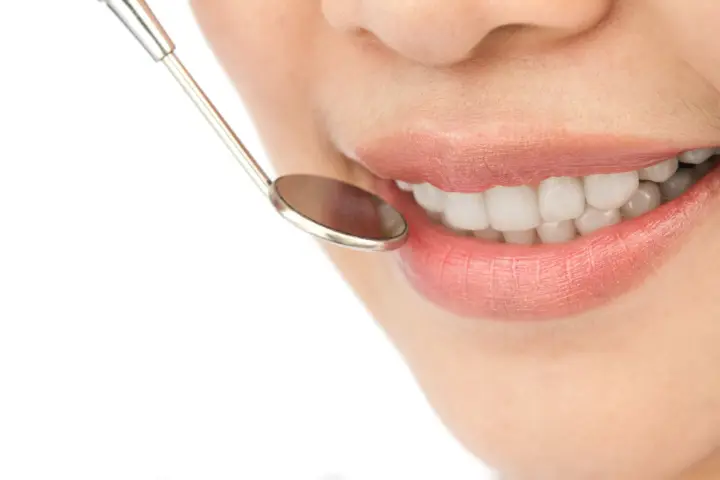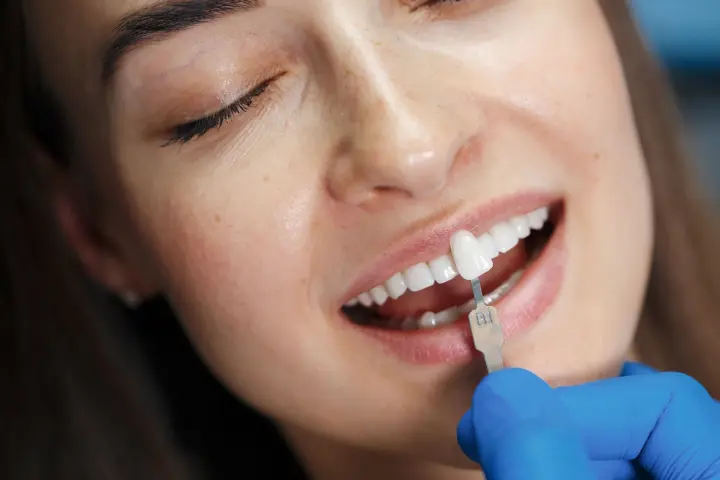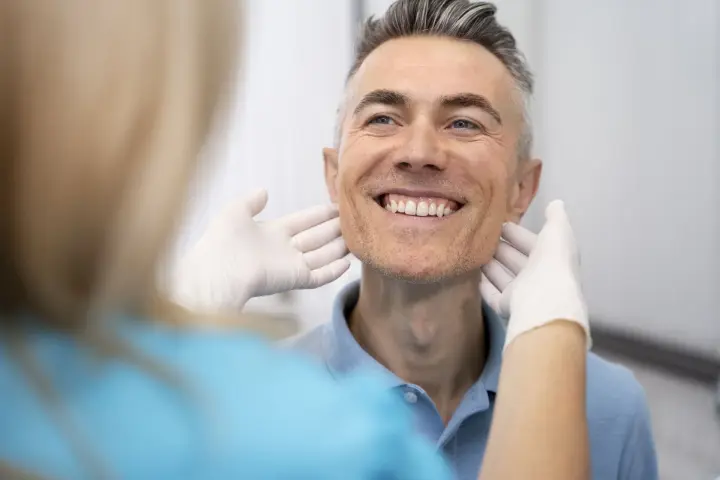The transformation seems almost magical—celebrities and public figures who once displayed imperfect teeth suddenly appearing with flawless, luminous smiles. Behind these remarkable metamorphoses often lies one of modern dentistry's most sophisticated aesthetic solutions: porcelain veneers.
These ultra-thin ceramic facades represent the intersection of advanced dental materials, meticulous clinical technique, and artistic vision. At Vident Dental Clinic, we've helped countless patients achieve their ideal smiles through this transformative procedure. This comprehensive guide explores the fascinating world of porcelain veneers—from their composition and creation to the factors that ensure their longevity.
Beyond the Red Carpet: Understanding Modern Veneers
While often associated with celebrity smile makeovers, porcelain veneers have evolved into a sophisticated solution accessible to anyone seeking aesthetic enhancement with minimal biological compromise.
The Evolution of Veneer Technology
Today's veneers bear little resemblance to their predecessors:
- First-generation veneers (1980s) required significant tooth reduction and offered limited translucency
- Second-generation systems (1990s) introduced more conservative preparations but still lacked natural optical properties
- Contemporary veneers utilize advanced ceramics as thin as 0.3mm, often requiring minimal or no tooth reduction while delivering unprecedented optical characteristics
This evolution has transformed veneers from obvious artificial enhancements to virtually undetectable aesthetic solutions that mimic natural tooth structure in every dimension.
The Ceramic Distinction
The term "porcelain" actually encompasses several distinct ceramic materials, each with unique properties:
- Feldspathic porcelain: Hand-layered by master ceramists, these traditional veneers offer exceptional aesthetics but moderate strength
- Pressed ceramics: Including lithium disilicate and leucite-reinforced materials, these provide enhanced durability while maintaining excellent translucency
- Zirconia-based ceramics: Ultra-high-strength materials ideal for specific clinical situations requiring maximum durability
The selection of ceramic system depends on multiple factors including aesthetic requirements, functional considerations, and the specific clinical situation.
The Transformation Process: From Consultation to Completion
The journey to a veneer-enhanced smile involves multiple precisely choreographed steps, each critical to the final outcome.
Comprehensive Aesthetic Analysis
The foundation of successful veneer treatment begins with a thorough assessment:
- Facial evaluation: Analyzing facial symmetry, midlines, and proportions to ensure harmony
- Smile dynamics: Examining lip movement during speech and various smile types
- Occlusal assessment: Identifying functional patterns that might affect veneer longevity
- Existing tooth analysis: Documenting shade, shape, and position of natural teeth
- Comprehensive imaging: Gathering photographs and possibly 3D scans for detailed planning
This multi-dimensional analysis ensures that the final result complements not just the teeth but the entire facial aesthetic.
Digital Smile Design and Visualization
Modern veneer planning utilizes advanced technology to preview results:
- Digital smile simulation: Software that allows visualization of potential outcomes
- Virtual wax-up: Computer-generated models of proposed changes
- Augmented reality applications: Technology that shows potential results in real-time
- Physical mock-ups: Direct application of temporary material to preview changes
These visualization tools allow patients to actively participate in designing their new smile, ensuring expectations align with clinical possibilities.
The Preparation Appointment
When the treatment plan is finalized, the preparation phase begins:
- Conservative preparation: Removal of minimal enamel (typically 0.3-0.5mm) or sometimes none at all with "no-prep" veneers
- Preservation of enamel: Maintaining this crucial outer layer whenever possible for optimal bonding
- Margin design: Creating precise boundaries that ensure seamless integration
- Tissue management: Gentle techniques that protect gum health while capturing perfect impressions
- Provisional veneers: Fabrication of temporary restorations that protect teeth and preview the final result
This phase requires exceptional precision—measurements are made in tenths of millimeters, with even slight variations potentially affecting the final outcome.
The Artistry of Veneer Fabrication
While hidden from the patient's view, the laboratory phase involves remarkable craftsmanship:
- Master model creation: Development of precise replicas of the prepared teeth
- Layering technique: Application of multiple ceramic materials to mimic natural tooth structure
- Characterization: Addition of subtle effects like micro-texturing, translucencies, and color variations
- Firing cycles: Precise temperature control to develop optimal ceramic properties
- Finishing and polishing: Meticulous detailing to create life-like surface texture
The most skilled ceramists incorporate minute details that catch and reflect light exactly as natural teeth do, creating what dental professionals call "vital luminescence."
The Delivery Appointment
The culmination of the process occurs when veneers are permanently bonded:
- Trial placement: Evaluation of fit, contour, and aesthetics before final cementation
- Shade verification: Confirmation of color match with try-in pastes
- Surface preparation: Specialized treatment of both tooth and veneer surfaces
- Adhesive application: Use of sophisticated bonding agents that create micromechanical attachment
- Light activation: Precisely timed curing to optimize bond strength
- Final adjustments: Meticulous refinement of occlusion and surface texture
This bonding process creates a union between veneer and tooth that, when properly executed, can maintain integrity for many years.
Material Science: The Chemistry Behind the Beauty
The remarkable aesthetics and durability of modern veneers stem from sophisticated material compositions that continue to evolve.
Optical Properties and Natural Appearance
The visual magic of premium veneers comes from their complex interaction with light:
- Translucency gradient: Varying degrees of light transmission from the gum line to the biting edge
- Fluorescence: The ability to absorb invisible ultraviolet light and emit visible light
- Opalescence: Creating blue and amber color shifts depending on viewing angle
- Metamerism resistance: Maintaining consistent appearance under different lighting conditions
These properties allow veneers to replicate the depth and vitality of natural teeth rather than appearing as flat, opaque surfaces.
Strength Considerations
Modern ceramic materials balance aesthetics with impressive durability:
- Flexural strength: Resistance to bending forces during function
- Fracture toughness: Ability to resist crack propagation
- Wear compatibility: Ensuring veneers won't damage opposing teeth
- Fatigue resistance: Maintaining structural integrity through repeated stress cycles
The latest generation of ceramics achieves flexural strength exceeding 400 MPa while maintaining optical properties indistinguishable from natural enamel.
Bonding Chemistry
The invisible foundation of veneer success lies in the adhesive interface:
- Silane coupling agents: Molecules that create chemical bonds between ceramic and resin
- Phosphate monomers: Compounds that bond to tooth structure
- Resin cements: Specialized materials that fill microscopic gaps while providing color stability
- Polymerization technology: Advanced curing methods that ensure complete hardening
This sophisticated chemistry creates bonds that can withstand decades of function when properly executed.
Design Principles: The Aesthetic Framework
Creating truly beautiful veneers involves adherence to established aesthetic principles while incorporating individual characteristics that prevent an artificial appearance.
Proportion and Symmetry
Mathematical relationships guide veneer design:
- Width-to-length ratios: Ideally between 75-85% for central incisors
- Golden proportion: A mathematical relationship between the visible widths of anterior teeth
- Axial inclination: The slight mesial tilt that characterizes natural teeth
- Incisal embrasures: Progressive deepening of spaces between biting edges
- Gingival architecture: Harmonious scalloping of gum tissues framing the teeth
These principles provide the framework for pleasing proportions while allowing for customization.
Natural Characterization
Avoiding the "piano key" appearance requires subtle incorporation of natural variations:
- Microanatomy: Surface textures that mimic natural enamel patterns
- Polychromatic effects: Gradual transitions between colors rather than monochromatic appearance
- Developmental grooves: Vertical lines that provide visual interest
- Incisal translucency: Varying degrees of transparency at the biting edge
- Subtle asymmetries: Minor variations that prevent an artificial appearance
The most sophisticated veneer cases incorporate these elements in a way that appears completely natural while eliminating actual flaws.
Functional Integration
Aesthetic considerations must always balance with functional requirements:
- Occlusal harmony: Creating proper contact relationships during chewing movements
- Anterior guidance: Developing appropriate relationships during forward and side-to-side movements
- Phonetics: Ensuring proper tooth positioning for clear speech
- Envelope of function: Staying within the boundaries of comfortable muscle movement
- Proprioceptive feedback: Maintaining the natural sensory awareness during function
This integration of function with aesthetics ensures that veneers not only look beautiful but also contribute to comfortable, efficient oral function.
Ensuring Longevity: Maintenance and Protection
With proper care and protection, porcelain veneers can maintain their beauty for 10-20 years or more. Several factors influence their lifespan.
Daily Maintenance Protocol
Routine care forms the foundation of veneer longevity:
- Effective but gentle brushing: Using non-abrasive dentifrices and soft bristles
- Interdental cleaning: Careful flossing or use of interdental brushes
- Rinse selection: Avoiding highly acidic or alcohol-based formulations
- Hydration: Maintaining adequate saliva flow to protect margins
- Periodic professional maintenance: Regular hygiene visits with veneer-safe polishing protocols
These basic practices help preserve both the veneers themselves and the critical margin areas where they meet the natural tooth.
Protective Strategies for High-Risk Factors
Certain conditions require additional protective measures:
- Bruxism management: Custom occlusal guards for patients who clench or grind
- Bite adjustment: Precise modification of contacts to distribute forces evenly
- Sports protection: Custom athletic mouthguards for active patients
- Acid control: Management of reflux or dietary acids that could affect bonding
- Parafunctional awareness: Techniques to reduce unconscious habits that stress restorations
Identifying and addressing these risk factors significantly extends veneer lifespan.
Professional Maintenance Considerations
The dental team plays a crucial role in veneer preservation:
- Specialized hygiene protocols: Use of appropriate instruments and polishing materials
- Regular margin evaluation: Monitoring the critical junction between veneer and tooth
- Surface assessment: Checking for early signs of wear or damage
- Occlusal analysis: Verifying stable and even force distribution
- Photographic documentation: Tracking subtle changes over time
These professional monitoring protocols allow early intervention for any developing issues.
Addressing Complications
Even with perfect care, issues may occasionally arise:
- Chip management: Conservative repair techniques for minor fractures
- Debonding protocols: Specialized approaches for reattachment if necessary
- Stain intervention: Professional procedures for addressing surface discoloration
- Margin refinement: Techniques for managing minor discrepancies at the edges
- Replacement strategies: Approaches for renewal when eventually needed
Many complications can be addressed conservatively when caught early, highlighting the importance of regular professional evaluation.
Candidacy Considerations: Are Veneers Right for You?
While veneers offer remarkable aesthetic potential, they aren't the ideal solution for everyone. Several factors influence their appropriateness for individual situations.
Ideal Clinical Scenarios
Veneers typically excel in addressing:
- Color issues resistant to whitening: Tetracycline staining, fluorosis, or internal discoloration
- Minor alignment discrepancies: Slight rotations or position issues
- Shape concerns: Peg laterals, worn edges, or congenital form problems
- Surface texture abnormalities: Enamel defects or irregular development patterns
- Diastema closure: Gaps between teeth requiring width modification
These situations often respond beautifully to veneer treatment with minimal biological compromise.
Situations Requiring Alternative Approaches
Some conditions may suggest different solutions:
- Significant crowding or misalignment: Often better addressed with orthodontics
- Extensive structural damage: May require full-coverage restorations
- Severe bruxism without management: High risk for fracture without addressing underlying issue
- Active periodontal disease: Requires stabilization before cosmetic treatment
- Insufficient enamel: May compromise bonding potential
A comprehensive evaluation determines whether veneers represent the optimal approach for your specific situation.
The Vident Approach to Veneer Assessment
At Vident Dental Clinic, our veneer consultation process includes:
- Comprehensive aesthetic evaluation: Detailed analysis of facial and dental aesthetics
- Functional assessment: Thorough examination of occlusion and jaw function
- Risk factor identification: Evaluation of elements that might affect longevity
- Treatment simulation: Digital and/or direct mock-ups to visualize potential results
- Material selection guidance: Recommendations based on your specific clinical situation
This thorough approach ensures that veneer treatment, when recommended, has the highest probability of meeting both aesthetic goals and longevity expectations.
Beyond the Surface: The Psychological Impact of Veneer Treatment
The transformation veneers provide often extends far beyond aesthetic improvement, influencing how patients perceive themselves and interact with others.
Confidence Transformation
Research consistently demonstrates psychological benefits:
- Social interaction changes: Many patients report increased willingness to engage socially
- Professional impact: Studies indicate positive effects on career advancement and opportunities
- Smiling frequency: Objective measures show increased smiling after aesthetic improvement
- Perceived age: Surveys indicate that observers often perceive individuals with aesthetic dental treatment as younger
- Self-image enhancement: Psychological assessments reveal improved self-perception following smile enhancement
These benefits often represent the most meaningful outcomes of veneer treatment, transcending the physical changes.
The Investment Perspective
When considering veneers, many patients benefit from viewing them as a long-term investment:
- Cost-benefit analysis: Evaluating the value of improved confidence and appearance over many years
- Longevity factors: Understanding how proper care extends the functional lifespan
- Alternative comparison: Considering the cumulative cost of repeated temporary solutions
- Quality distinctions: Recognizing the significant differences between economy and premium veneer options
- Maintenance economics: Appreciating how preventive care maximizes return on investment
This perspective helps patients make informed decisions aligned with their personal values and priorities.
Conclusion: The Harmony of Art and Science
Porcelain veneers represent one of dentistry's most elegant solutions—where scientific principles of materials, chemistry, and function merge with artistic elements of proportion, light, and individual expression. When properly planned and executed, they offer transformative potential with remarkable longevity.
At Vident Dental Clinic, we believe that exceptional veneer results emerge from the collaboration between skilled clinicians, master ceramists, and well-informed patients. Our approach emphasizes comprehensive planning, meticulous technique, premium materials, and ongoing support to ensure your veneer experience meets the highest standards of both aesthetics and durability.
Whether you're considering veneers to address specific concerns or seeking a complete smile transformation, we invite you to explore whether this remarkable treatment option might be right for you. Contact us to schedule a consultation and discover how the art and science of modern veneers might enhance your smile and confidence for years to come.
This article provides educational information about porcelain veneers. For personalized recommendations, please schedule a consultation with our dental team at Vident Dental Clinic.



